30.03.2023
On life, sensuality and being an artist
Εικαστικες Τεχνες
Γλώσσα πρωτότυπου κειμένου: Αγγλικά
Looking at Eleni Bagaki’s latest series of paintings at the National Museum of Contemporary Art in Athens (EMST) entitled Something like a poem, a nude, and flowers in a vase, I think spontaneously of Celia Hampton’s work. Beyond the fact that both artists represent male nudes from a female perspective, their respective artistic processes intersect at the boundary between life and work. Hampton’s paintings represent close-ups of men’s genitals she encounters during her live chat conversations with strangers on websites from her intimate space, while Bagaki’s work derives from her experience of strolling during working hours in the quasi empty Pedion Areos park, in central Athens. This measured quantity of nature within the cityscape is a liberating background for the artist to project her fantasies and observe the non-verbal communication between its temporary habitants. Inspired by postures of men in advertisements and magazines, the artist places their naked silhouettes in scenes of nature within her work in a palette ranging from pastel yellow, orange, pink to light blue. Their inviting figures, devoid of any aggressive masculinity, appear elusive as they emerge effortlessly through the canvas.
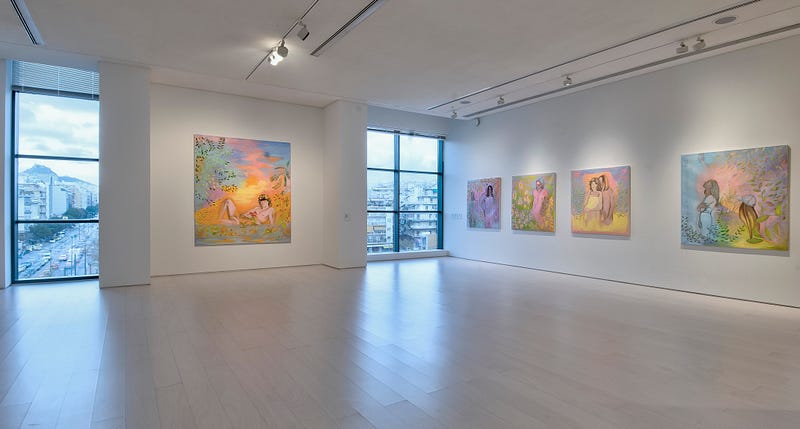
Nakedness had not appeared this way in Bagaki’s previous works. Fragmented body parts, like in her work Torso (2016) or in the publication Ding Dong Dick (2013) and sex toys such as those in her painting Just kidding (Dildo in the woods) (2020) were part of a wider narrative in which they appeared misplaced or dehumanized. Interestingly, a body part to which she refers obsessively is the foot. Such is the case in her video She was whistling he was shooting (2016) where we look at the artist’s feet with sneakers for several minutes while subtitles inform us of an impossible love story, or in her video There, only feet matter, (2018) or again in Sock Tune (2015). There is also a reference to both legs and feet in her work Poems for him (2023), presented in dialogue with the paintings at EMST:
“̵T̵h̵i̵s̵ ̵i̵s̵ ̵a̵ ̵l̵e̵g̵
I have no feelings for this leg anymore
He also had other body parts
He wasn’t just a leg
[…]
His shoe size was 47”
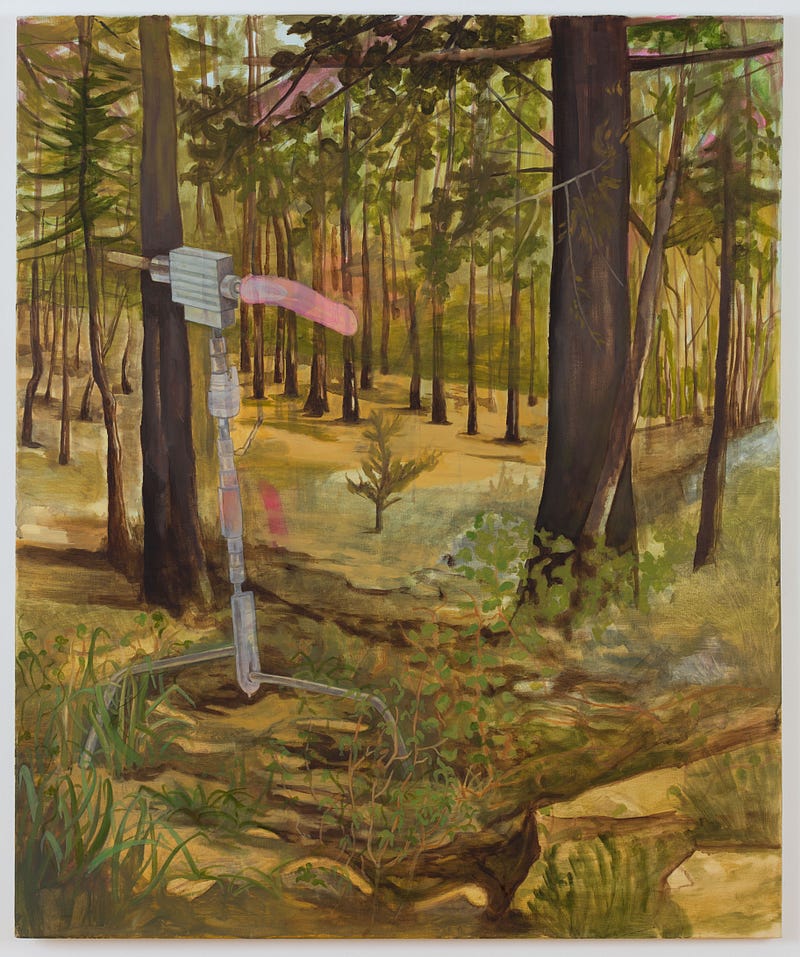
Bagaki uses various mediums in her work, such as video, text, painting, and installations. Each of them seems to borrow characteristics from the content of the work, and vice versa. For her first institutional show in Athens, she chose to present a less known aspect of her work, that is painting; this was partly for practical reasons, as the nomadic life she led during multiple residencies did not allow for a stable working space, which she only found upon moving back to Athens. Compared to the photographic image or video that confronts us with reality, painting, like writing, offers a coded image of reality leaving space for the artist to shift multiple roles, and disguise herself. For example, Bagaki’s videos are usually marked by a lack of action; we see her reclining (Reclining artist, the artist is reclining, 2021), driving, eating, looking (Making a movie in solitude and in conversation with others, 2020); other times, they are devoid of the human element, like in her work The Film (2017). In these cases, all the action takes place in a parallel layer through her text, appearing in the form of subtitles without any sound of human voice. If the image of the artist is there, she plays herself.
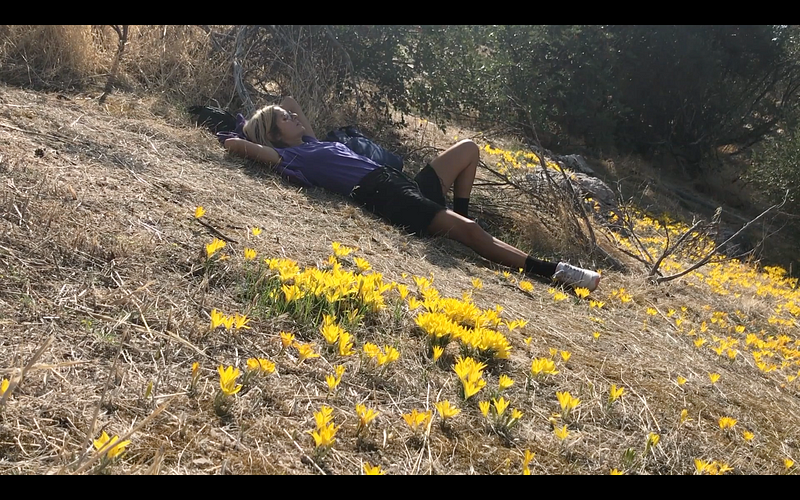
The choice of painting allows the artist to fully present a fantasy that works simultaneously as a means of prevention shield but also as a reaction against the male gaze. These works constitute impulsive exercises that reverse the male gaze that she, like all women, has experienced in public space, and that for personal reasons (and not for the sake of a heteronormative representation) take on a male form in her work. This feeling is extended in the exhibition space, where the visitor becomes an exhibit as she/he is invited to sit on the bench-like seat to experience her work, multiplying the intersections of the gazes.
Her research on the gaze brings two more thoughts/references to mind: Barbara Kruger’s Your gaze hits the side of my face (1981), and an excerpt from Bagaki’s publication She left, she left again, she left once more (2022) that she wrote during her residency in Fogo Island:
“I look at myself in the mirror and touch my face and body
to prove that I am here. I repeat: “The lack of someone
else’s gaze doesn’t make me invisible.”
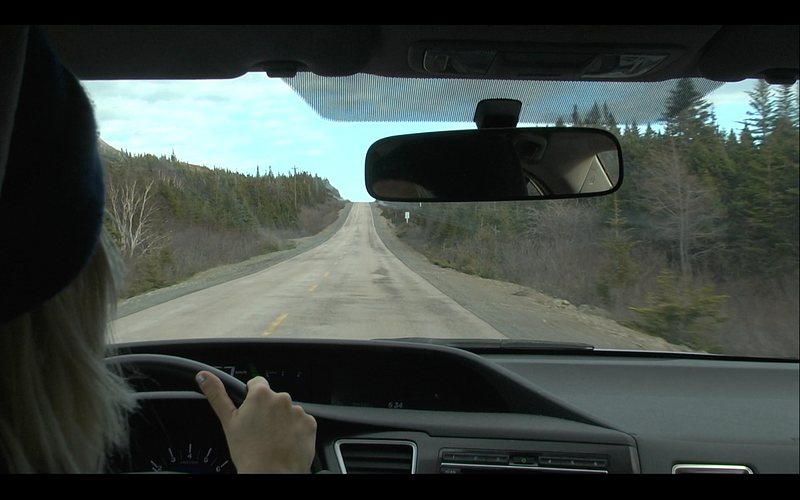
Τhe gaze of others can be aggressive and irritating but it can also signify existence through attention-something the artist seeks to resist. Her work also contains her gaze on herself, a continuous process of introspection. In this process, her status as an artist could hardly be absent, as this element is something to which Bagaki keeps on returning in an attempt to affirm it. It is a role that, as presented to us through methodically woven conversations between women and men, occurring over the course of a romantic relationship (or in a potential one) between herself and the other, is not easily understood and accepted, like in this excerpt from her video The Film (2017):
“He said he didn’t like art, he liked films. […]
I said I wanted to do a film too.
He laughed.
He said films are hard to make.
He said female filmmakers are not good enough.”
or from her text in She left, she left again, she left once more:
“I talked to him about my art project on embracing precarity and pursuing a nomadic artistic life. I told him that traveling alone can be scary and very difficult, but I hoped to grow more confident. He interrupted me, “…and you call this art?”
“…yes,” I said, feeling confused.
“Oh, you, artists! Whatever you do, you call it art. You travel, it’s art! You are alone; it’s art! Everything you do, you think it’s art!”
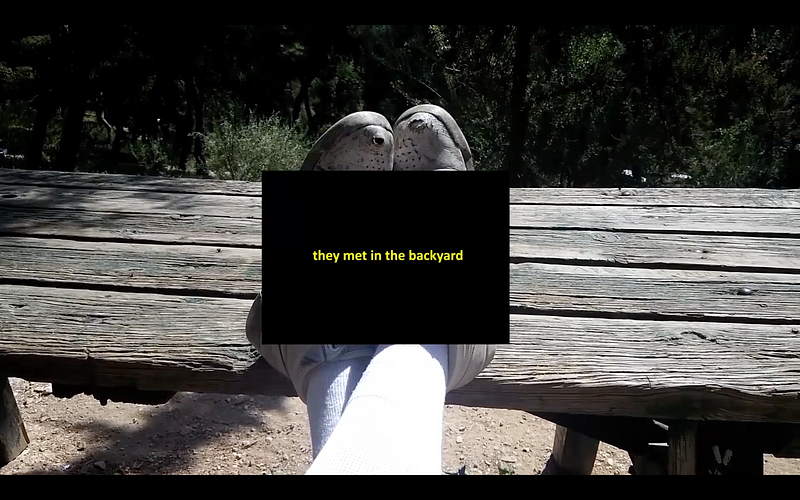
These general conclusions, like gazes, are what the artist (or narrator) receives for who she is. Bagaki’s research around what it means to be an artist from her own point of view and that of others, concretized in the presence of other female artists as presented in the video Making a movie in solitude and in conversation with others (2020), realized during her two-month stay on Fogo Island, Canada. In the work, we see her driving through empty streets on the island, a ride interrupted by scattered excerpts from interviews of female artists, mainly filmmakers, since she herself uses this medium. Quotes in the video that revolve around the issue of existence such as “In life you very often encounter impasse. But that impasse turns out ultimately to be a passage. It is a way of leading you to an elsewhere”, (Trinh T. Minh-ha) or belonging such as “I don’t feel that I belong, at all. Sometimes it’s hard because belonging can give you a kind of peacefulness but I don’t, I don’t belong.” (Chantal Akerman) seem to echo the artist’s own concerns. In one of the quotes, Sheila Heti refers to her own model of artists on the process of finding your voice as an artist, something that is central in Bagaki’s work: “To me, what the artists that I love, model is that just kind of freedom, and there is discipline in it too. But it’s the discipline of doing what you want to do. And it’s very hard to do what you want to do. It takes forever to do what you want to do.”
Whatever the medium, Bagaki is balancing between the rawness of reality, idealized expectations and representation, through “transporting” moments of the everyday into her work from the female perspective. This seemingly personal experience weighs, through the subject of love and romance, the possibilities of communication between man and woman, reflecting a woman’s place in society and functioning as a social psychograph. Autobiographical or fictional, Bagaki’s body of work is dedicated to the research of “what she wants to do”, of finding the self (or better, selves) that involve a third curious presence, a potential viewer through the sensual anticipation created.
Εva Vaslamatzi
Eleni Bagaki is an artist and writer based in Athens. She holds an MA in Fine Arts from Central Saint Martins, University of the Arts, London. Drawing inspiration from feminist approaches and practices, she uses her work to explore autobiography and its relationship to fiction through texts, videos, sound, painting, and sculpture.
Solo Exhibitions include: Something like a poem, a nude, and flowers in a vase, (National Museum of Contemporary Art Athens, 2023, She left, she left again, she left once more, (Aghios Rokkos, Chania, 2022), Falling into whispers and kisses, Chauffeur Gallery, Sydney and Reclining Artist, the Artist is reclining, Eleni Koroneou Gallery (2021); The importance of reading, writing, and exfoliating, Palette Terre, Paris (2018); A book, a film, and a soundtrack, Radio Athènes, Athens (2017); Economy Class, Signal Center for Contemporary Art, Malmö (2016); Now you see me, oh now you don’t, NEW STUDIO, London and Crack, Crack, Pop, Pop…oh what a relief it is!, Radio Athènes, Athens (2015)
Selected Group Exhibitions include: This current between us, Former Neo Faliro Power Station, Athens, Moods & Memories, Eleni Koroneou Gallery, Athens, Sheltered Gardens, Diomedes Botanic Garden, organized by PCAI, Athens, Ιdeas and Solutions for Υour Home, 3137, Athens, Femme4Femme4ever, Haus N Athens, Athens, Directed by Desire, Rongwrong, Amsterdam and Bread and Digestifs, Callirrhoë, Athens (all 2022); La vie gagneé, Syndicate potentiel, Strasbourg, Off Season, 9th Syros International Film Festival, Syros, Prizing Eccentric Talents, P.E.T. Projects, Athens (all 2021); Be water again, Koraï, Nicosia, A imensa preguiça, Sancovsky gallery, Sao Paulo, Seeping upwards, rupturing the surface, Art Gallery of Mississauga (all 2018); Vilniaus kontekstai, Vilnius, Millennial Feminisms, L’Inconnue gallery, Montreal (2018) The Equilibrists, DESTE Foundation and NEW MUSEUM, Athens (2017)
Bagaki is the recipient of the Artworks Fellowship, Niarchos Foundation (2020–21), the NEON Exhibition Grant, Athens and Pivô Artist Grant, Sao Paulo (2018), The Outset Greece 2017 Grant, and the Celeste Art Prize (2007). Residencies include: Hordaland Kunstsenter, Bergen (2020), Fogo Island Arts’ Residency, Canada (2019), IASPIS, Stockholm (2018–19), Pivô, Sao Paulo (2018) and Kantor Foundation (2017).
Some of her published books are Poems for him, 2023, Butter and Cracker, dolce, 2022, She left. She left again. She left once more, 2021, No script, 2017, and Look for love and find a log instead, Tadeusz Kantor Foundation, 2017.
Eva Vaslamatzi (SNF ARTWORKS Fellow 2019) is an independent curator and writer currently based in Athens, Greece.



